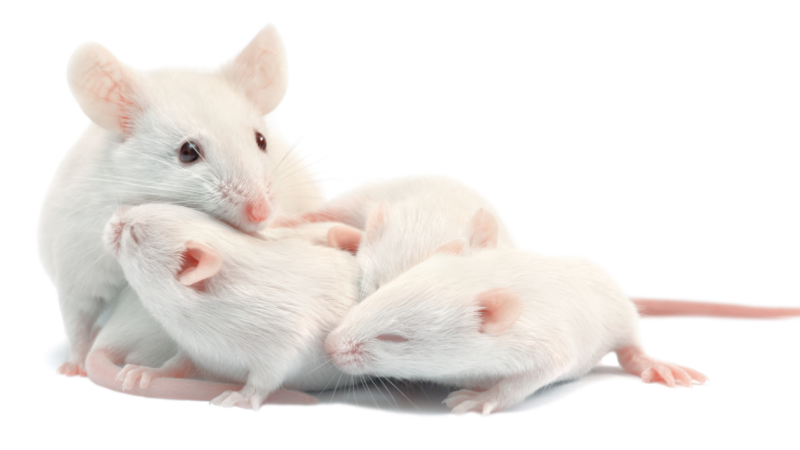Human gene variant alters the voices of mice
Putting the uniquely human version of a certain gene into mice changed the way that those animals vocalized to each other, suggesting that this gene may play a role in speech and language.
Mice make a lot of calls in the ultrasonic range that humans can’t hear, and the high-frequency vocalizations made by the genetically altered mice were more complex and showed more variation than those made by normal mice, according to a new study in the journal Nature Communications.
The fact that the genetic change produced differences in vocal behavior was “really exciting,” says Erich Jarvis, a scientist at Rockefeller University in New York who worked on this research.
Still, he cautioned, “I don’t think that one gene is going to be responsible — poof! — and you’ve got spoken language.”
For years, scientists have been trying to find the different genes that may have been involved in the evolution of speech, as language is one of the key features that sets humans apart from the rest of the animal kingdom.
“There are other genes implicated in language that have not been human-specific,” says Robert Darnell, a neuroscientist and physician at Rockefeller University, noting that one gene called FOXP2 has been linked to speech disorders.
He was interested in a different gene called NOVA1, which he has studied for over two decades. NOVA1 is active in the brain, where it produces a protein that can affect the activity of other genes.
NOVA1 is found in living creatures from mammals to birds, but humans have a unique variant. Yoko Tajima, a postdoctoral associate in Darnell’s lab, led an effort to put this variant into mice, to see what effect it would have.
One part of the study involved recording the mice making ultrasonic chirps. These cries typically occur when pups are separated from their mothers, and later in life males string similar sounds together into songs that they use to woo female mice.
“They’ll sing them to the females as a courtship behavior,” explains Jarvis.
It turns out that genetically altered mouse babies born in the same litter as normal mice chirped differently to get their mother’s attention, the study found.
“The quality and quantity of the chirping was distinctly different in the humanized mice,” says Darnell.
And genetically altered adult males sang notably different romantic songs. “They mix it up more,” notes Jarvis.
What’s more, the researchers note that some of the other genes affected by NOVA1 are known to be related to vocal behavior.
To confirm that this genetic variant was truly unique to modern humans, they did an analysis that checked genomes from extinct human species, the Neanderthals and Denisovans.
What they found is that these ancient lineages lacked this variant, but it was present in the genomes of over 650,000 genomes of modern humans from around the world that are held in databases. Only six modern genomes had the ancient version of NOVA1, but nothing is known about those individuals, the researchers note.
The study intrigued Cedric Boeckx, a researcher with the Catalan Institute for Advanced Studies and Research and the University of Barcelona, who called it “a real advance.”
“It takes a gene that people had already singled out as having a mutation that’s specific to Homo sapiens, that’s not present even in our most closely related relatives, the Neanderthals and Denisovans, and it tries to figure out what this mutation could have done,” he explains.
Previous work looked at this gene in lab-grown mini-brains. Doing this in mice allowed scientists to watch how it affected behavior, but Boeckx cautions that studies in mice have inherent limitations when it comes to understanding speech and language.
“The mouse is not your typical vocal learner,” says Boeckx. “It produces vocalization but they are mostly innately constrained. So it’s not like us.”
Still, he thinks it will make scientists even more interested in probing the effects of this uniquely-human genetic variant as well as how it might interact with other genes known to be involved in language.
After all, he says, humans are special in how we communicate, and knowing the list of genes involved in language “could tell us something about how we came to be who we are.”
Trump signs executive actions on education, including efforts to rein in DEI
The directives include new efforts to curtail DEI programs at colleges, and discipline guidance for public schools.
A dozen states sue the Trump administration to stop tariff policy
A dozen states have sued the Trump administration in the U.S. Court of International Trade to stop its tariff policy, challenging Trump's claim that he could arbitrarily impose tariffs based on the International Emergency Economic Powers Act.
Air pollution still plagues nearly half of Americans. That does a number on our health
Despite improvements in air quality in past decades, 156 million Americans still breathe in too much soot or ozone, says the annual State of the Air report from the American Lung Association.
Eli Lilly sues companies selling alternative versions of its weight loss drug
The drug company Eli Lilly is suing four telehealth companies for allegedly selling copies made by compounding pharmacies of its drug Zepbound.
After a scathing rebuke, judge grants DOJ an extension in deportation case
A federal judge gave the Trump administration another week to answer detailed questions about Kilmar Abrego Garcia, the Maryland man whose illegal deportation has raised concerns about due process.
Funding cut for landmark study of women’s health
The Women's Health Initiative, begun in the 1990s, has made many important discoveries. Now funding to collect more research data will end in September.









